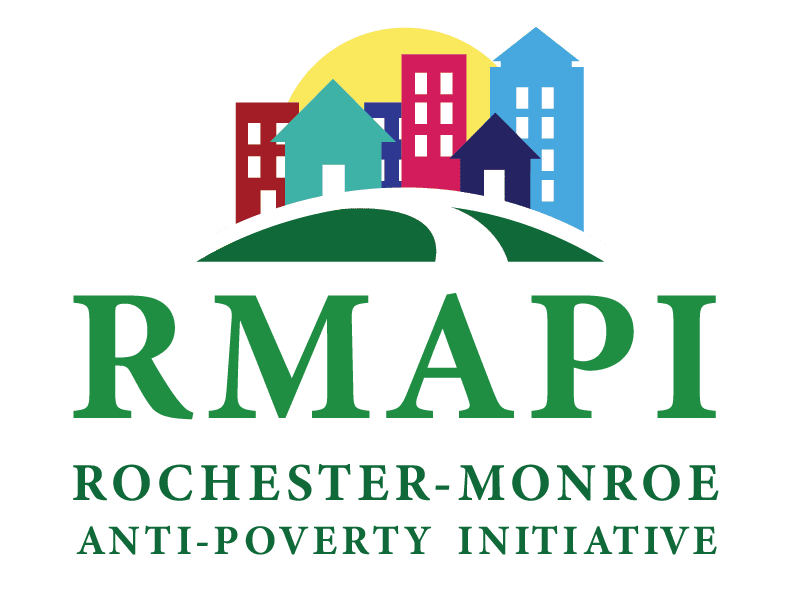Ending Poverty
Understanding Poverty
Pervasive, long-standing, deeply rooted poverty is the greatest crisis the Rochester area has ever faced. Without a new approach, it will continue to get worse.Our work attackspoverty at its root causes, addressing the systems that have perpetuated poverty and the structural racism that underpins these systems.

The basics of
poverty.
Pervasive long-standing, deeply rooted poverty is Rochester’s greatest crisis and requires a new, innovative approach to combat it. Our work attacks poverty at its root causes, addressing the systems that have perpetuated poverty and the structural racism that underpins these systems.
Step into the shoes of someone experiencing poverty. play the game spent.
The Fish, the Lake, and the Groundwater.
Structural racism and poverty are complex concepts. In an effort to try to make them easily understandable, we adapted this version of “the Groundwater” as a metaphor for systemic poverty. The model is adapted from Bayard Love and Deena Hayes-Greene of the Racial Equity Institute.
Imagine you have a lake in front of your house and you come outside one morning to find one fish is floating belly-up dead. If that happens, it makes sense to analyze the fish. What is wrong with it? Imagine the fish is one person living in poverty. We’d ask: Did it work hard enough? Is it incapable of finding a job?
But if you come out to that same lake and half the fish are floating belly-up dead, what should you do? This time you’ve got to analyze the lake. Imagine the lake is our economic system and half the people are struggling. This time we’d ask: Might the system itself be causing such consistent, unacceptable outcomes for people living in poverty? If so, how?
Now… picture five lakes around your house, and in each and every lake half the fish are floating belly-up dead! What is it time to do? We say it’s time to analyze the groundwater. How did the water in all these lakes end up with the same contamination? On the surface the lakes don’t appear to be connected, but it’s possible—even likely—that they are. In fact, over 95% of the freshwater on the planet is not above ground where we can see it; it is below the surface in the groundwater.
This time we can imagine half the people in a given region are living in poverty, half the people suffer from ill health, half are performing poorly in the criminal justice system, half are struggling in and out of the welfare system, and it’s often the same people in each system!
By using a “groundwater” approach, one might begin to ask these questions: Why are educators creating the same racial inequity as doctors, police officers, and social workers? How might our systems be connected? Most importantly, how do we use our positions in one system to impact a structural racial arrangement that might be deeper than any single system? To “fix fish” or clean up one lake at a time simply won’t work—all we’d do is put “fixed” fish back into toxic water or filter a lake that is quickly recontaminated by the toxic groundwater.
Our groundwater metaphor is designed to help people internalize the reality that we live in a racially structured society, and that that is what causes racial inequity. The metaphor is based on three observations: racial inequity looks the same across systems, socioeconomic difference does not explain the racial inequity; and inequities are caused by systems, regardless of people’s culture or behavior. Embracing these truths forces leaders to confront the reality that all our systems, institutions, and outcomes emanate from the racial hierarchy on which the United States was built. In other words, we have a “groundwater” problem, and we need “groundwater” solutions.
Helpful resources to understand poverty.
Poverty isn't a lack of character; it's a lack of cash
“Ideas can and do change the world,” says historian Rutger Bregman, sharing his case for a provocative one:
guaranteed basic income. Learn more about the idea’s 500-year history and a forgotten modern experiment where it actually worked — and imagine how much energy and talent we would unleash if we got rid of poverty once and for all.
Housing Segregation and Redlining in America: A Short History
In 1968, Congress passed the Fair Housing Act that made it illegal to discriminate in housing. Gene Demby of NPR’s Code Switch explains why neighborhoods are still so segregated today.
• Read “How Segregation Shapes Fatal Police Violence” at https://n.pr/2Ic6A1Q
• Read or listen to: “‘The Color Of Law’ Details How U.S. Housing Policies Created Segregation” at https://n.pr/2HgqATh
How America's justice system is rigged against the poor
There are invisible cages that extend far beyond prison walls.Every year, more than 600,000 individuals are freed from America’s jails and prisons.But many of America’s formerly incarcerated people face numerous obstacles when integrating back into public life once free, according to Wes Caines and his former colleagues Scott Hechinger and Hannah McCrea at Brooklyn Defender Services, a public defender service in New York City.
The RMAPI Collective is fighting to end poverty.
The RMAPI Collective has developed a set of systems outcomes and goals that define the work of our Unity Agenda. We looked at the barriers to upward mobility in our communities, collected input from content and context experts, and invited learnings from across the country. These statements reflect what it will look like when our goals are achieved, and be the visionary systems changes that we want to see.
